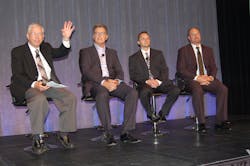DALLAS, TX. A panel discussion here at the 2014 Commercial Vehicle Outlook Conference examined some of the ways technology – including in-cab camera systems, performance scorecards and automated manual transmissions (AMTs) – is being used to “change” the truck driver culture to one focused on safer vehicle operation, greater fuel efficiency, and improved regulatory compliance.
Led by Paul Menig, CEO of Tech-I-M, the panel – part one of a broader two-day discussion dubbed “The Connected Fleet” at the conference – included Brent Nussbaum, CEO of TL carrier Nussbaum Transportation Services; Clay Merches, VP-safety & human resources for TL carrier J&R Schugel; and Gerard DeVito, executive director-next generation automated platform with Eaton Corp.
Nussbaum noted that his company – founded by his father in 1945 and today operating 245 trucks and 600 dry van trailers –uses highly-detailed performance “scorecards” called “Driver Excelerators” that track everything from out-of-route mile and on-time delivery arrivals to vehicle fuel economy, hard braking events, etc.
The point tally compiled via the scorecard puts Nussbaum’s drivers in bronze, silver, and gold categories and awards them monetary bonuses on a quarterly basis based on their numbers. Nussbaum said some of his company’s highest-performing drivers have collected as much as $1,800 per quarter in bonus money based on their performance metrics.
Merches notes that J&R Schugel, a 40-year old TL carrier operating 600 trucks and 1,200 trailers, uses Lytx’s DriveCam in-cab video system to analyze driver behavior, correct form and technique to improve safe driving skills, and above all over video proof to protect Schugel’s drivers in accident situations that are not their fault.
Merches noted that it’s the “little things” revealed by the in-cab video that Schugel believes offers an opportunity to improve safety and thus lower risk.
“How driver’s pre-check their mirrors, reducing speed in high-traffic areas, driving 2 to 3 miles per hour slower than the speed limit, leaving sight seconds of following distance between them and the vehicle in front of them – it’s these techniques that help them be safer drivers and the cameras allow us to focus and train them appropriately based on their actual behaviors,” he said.
Devito noted that greenhouse gas (GHG) regulations are forcing trucks to be more fuel efficient and offering technologies to drivers and fleets alike to help achieve the greatest fuel savings possible.
He said engines are shrinking in size from 15 liters to 12 liters, top engine speeds are declining from 1,400 rpm to 900 rpm, while engine braking power is dialing up 100 hp or more to provide stronger stopping power. AMTs are being adapted to such an environment to provide smaller gear “step” ranges as well as offer the ability to obtain better fuel economy.
“The rule of thumb now with transmissions is one size does not fit all,” Devito stressed. “We’re creating optimum shift points and ratios for a wide array of trucking operations so we can open up more ‘windows’ for fuel economy improvements.”
Menig mentioned that longer-term technologies on the horizon aimed at drivers include wearable computers that can monitor fatigue and gauge physical health metrics in real time – such as tracking blood sugar levels of diabetics – with hand-held hours of service (HOS) app options and more simulator-based training to help drivers be bettered prepared for emergency situations.
Yet Nussbaum stressed that, despite any and all such technology, it is the character of drivers that is fundamental to obtaining the benefits technology can offer.
“We prefer to hire those with strong character over experience,” he explained. “We can teach what a driver or other personnel needs to know for our business. But high standards of integrity, ethics and values are what make things like performance scorecards truly work. Culture opens that door.”
About the Author
Sean Kilcarr
Editor in Chief
Sean Kilcarr is a former longtime FleetOwner senior editor who wrote for the publication from 2000 to 2018. He served as editor-in-chief from 2017 to 2018.
